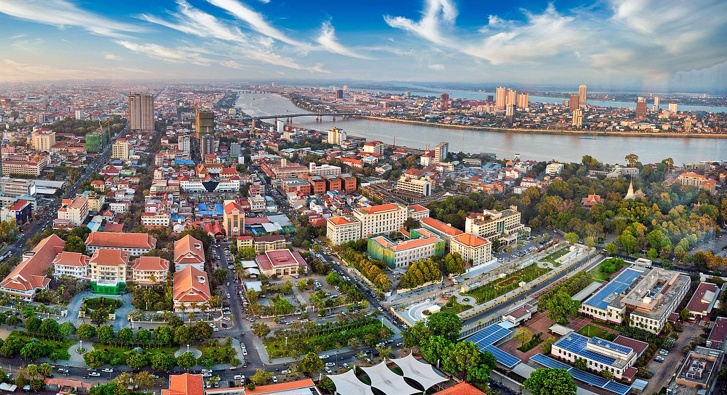Lusciously located at the confluence of the mighty Mekong and Tonle Sap rivers, the very name Phnom Penh conjures up an image of the exotic. I recently visited Cambodia’s capital with Emerald Cruises on their magnificent week-long float from Ho Chi Minh City. From the fluttering saffron robes of passing monks to the glimmering spires of the Royal Palace, Phnom Penh struts its Buddhist stripes at every turn. But the Cambodian capital’s shine was egregiously tarnished by the ravages of the Khmer Rouge regime. Forty years on, Phnom Penh aspires to be as electric as Bangkok or Ho Chi Minh City, with swanky new developments and the hip, edgy design boom revving up the city centre’s allure, and eye-catching skyscrapers extravagantly reframing the skyline. Come nightfall, there is no question that Phnom Penh is one of the most illuminated cities in Asia, radiantly aglow in the city’s insatiable obsession with playful, escapist light shows. The city is lit!
But the shameful shadow of Pol Pot and his abominable regime is a stain that cannot be airbrushed away – or joyfully dressed up in fairy lights. The past bastardry is still central to the city narrative. Remarkably, when the Khmer Rouge grabbed power, it forced most of its three million residents into the countryside, apart of its grand vision for a classless agrarian society. Today, Phnom Penh resembles a city of startling contrasts, from extreme poverty to ostentatious wealth. It’s a city gripped by entrenched state corruption and the reaffirming kindness of locals you meet. Virtually everyone I chatted to was scathing of Cambodia’s slavish dependence on China. Nearly 50% of their public debt is owed to China, with more “debt trap” loans in the works. Phnom Penh is a city where the streets have no name – merely numbers. The legacy of the Khmer Rouge looms large as one of the central reasons to visit the city and to reflect on history’s epic horrors, dipping into the darkest corners of the country's traumatised past. It’s an unvarnished, gut-wrenching experience.
My first shore excursion with Emerald Cruises was to one of Cambodia’s biggest Killing Fields. Under Pol Pot's maniacal rule from 1975 to 1979, roughly a quarter of Cambodia’s population was murdered, the genocide of roughly 2 million people. Tens of thousands of Khmer Rouge prisoners who had been tortured at the infamous S-21 prison were then taken just out of town to the Choeung Ek extermination camp, which was previously a Chinese cemetery and longan orchard. Prisoners would arrive blind-folded unaware of the brutality that was about to unfold. Our guide pointed out the tree named the Killing Tree, which is where children would be beaten to death. Another tree has been named the Music Tree. The Khmer Rouge executioners would hang speakers from the tree and blast out loud music to drown out the screams of people being bludgeoned to death, so that those awaiting their fate remained oblivious to the evil about to be unleashed.
 The Killing Tree. Photo / Mike Yardley
The Killing Tree. Photo / Mike Yardley
My guide soberly remarked that most people were viciously bludgeoned to death by farm implements, because the Khmer Rouge didn’t want to waste precious money on bullets. The most sickening spectacle at this site are the shards of bones and clothing sticking up from the vast mounds of dirt that mark the mass graves. Every time it rains, the earth reveals more and more of its sinister secrets, lurking beneath the surface. Most mass graves have been left untouched. Today the camp is a memorial site. A monumental 17-storey glass stupa, built 25 years ago, rises up from the centre, filled with 8,000 skulls, exhumed from the mass graves nearby. It's a harrowing spectacle – steel yourself. Many of the skulls, which are grouped according to age and sex, bear the holes and slices from the blows that killed them.
 Photo / Mike Yardley
Photo / Mike Yardley
Back in town, we visited the Tuol Sleng Genocide Museum, another horrific reminder of the cruelty humans are capable of inflicting. Once a neighbourhood high school, the building was seized by Pol Pot's Khmer Rouge and turned into a prison and interrogation centre, the dreaded S-21. During the prison's four years of operation, an estimated 20,000 Cambodians were tortured here before being transferred to the Killing Fields for execution. Initially it was the previous governments officials, academics, doctors, teachers, students, factory workers, monks and engineers that were imprisoned.
The regime was paranoid about educated Cambodians becoming CIA spies and went to outrageous lengths to interrogate inmates and force out confessions – many of which were false confessions. Prisoners were routinely beaten and tortured with electric shocks, searing hot metal instruments and hanging. Some were cut with knives or suffocated with plastic bags. Other methods for generating confessions included pulling out fingernails while pouring alcohol on the wounds and waterboarding prisoners. Even a Kiwi, Kerry Hamill, was tortured in the prison, before being executed. He was imprisoned along with his friends after sailing off the coast from Thailand and inadvertently straying into Cambodian territorial waters.
The four school buildings that made up S-21 have been left largely as they were when the Khmer Rouge left. The prison kept extensive records and photos of the victims, and many of the documents are on display; particularly chilling are the representations of torture scenes painted by S-21 survivor Vann Nath. He is just one of a handful inmates who walked out of the prison alive. His painting skills were his saving grace. Another survivor is Chum Mey. His life was only spared because of his ability to repair sewing machines for Pol Pot's soldiers. The 93 year old has appeared in numerous documentaries and still greets visitors most days in the museum courtyard.
 S21 Prison in Phnom Penh. Photo / Mike Yardley
S21 Prison in Phnom Penh. Photo / Mike Yardley
For a welcome change of scenery, we also headed to the bejewelled splendour Royal Palace, the official residence of current King Sihamoni. The residential areas of the palace re strictly off limits, but within the pagoda-style compound are several structures worth savouring, including the Silver Pagoda; the Throne Hall, with a tiered roof topped by a 200-foot-tall tower; and a pavilion donated by the Emperor Napoléon III and shipped here from France.
 Photo / Supplied
Photo / Supplied
The Temple of the Emerald Buddha, built from 1892 to 1902 and renovated in 1962, is one of Phnom Penh's greatest attractions. It's referred to as the Silver Pagoda because of the 5000 silver tiles—more than 5 tonne of pure silver—that make up the floor in the main temple hall. It’s also home to the Emerald Buddha—some say it's carved from jade, while others maintain that it's Baccarat crystal. In front of the altar is a 90kg solid-gold Buddha studded with over 2000 diamonds. Serious bling!
Just out of Phnom Penh, we also headed to Uodong, the former royal capital of Cambodia until it moved to Phnom Penh in 1886. It’s home to the burial sites of numerous Khmer kings and the Oudong Monastery. It was fascinating to interact with some of the nuns who live here – many who lost their husbands during the insanity of Pol Pot’s regime. Best of all, entering the grace and gorgeousness of the main temple, we received a traditional Buddhist blessing from a couple of resident monks.
 Photo / Mike Yardley
Photo / Mike Yardley
Shop up a storm in Phnom Penh. Bartering is expected and part of the fun at markets - just watch your wallet doesn't go walkabout with a fleet-footed pickpocket. Colourful krama (checked headscarves), weird and wonderful fruit, gemstones, fried grasshoppers -- it's all under one enormous Art Deco roof at Central Market. Haggle for handwoven silk, silver animal trinkets and Buddha carvings in the Russian Market's warren of dark alleys, which takes its name from the Russian wives who would previously sweep into town for a buying binge. Street 240 and Street 178 are the city's chicest boulevards, dotted with fashion boutiques, art galleries and bookstores.
Phnom Penh has a reputation for booming nightlife. Booming it is, but a large part of that is actually pretty seedy. As in Thailand, in some parts of town, child prostitution is rife. The main nightlife area, nicknamed The Strip is on Street 51, spills forth with young Khmer girls from the countryside, soliciting on the footpath, waiting for large old white men with fat wallets. I felt sick. For a classier, cleaner experience, head to the riverfront scene on Sisowath Quay, where the restaurants and bars party deep into the night – without the sleazy sex trade atmos.
Down on the quay, enjoy sizzling city views, cool breezes, cook-your-own-meat Khmer barbeque and rooftop cocktails at FCC, the Foreign Correspondents Club, a city institution housed in a French colonial gem. It is currently undergoing a major refresh, but the history runs deep here. Photos on the wall date back to the Khmer Rouge invasion, as taken by war correspondents who used to hang out at FCC back in the day.
 Photo / Supplied
Photo / Supplied
You’ll have a world of fun taking in the trippy night lights on a remork ride, as Phnom Penh spangles itself silly in splashy light displays. Good-cause dining is also big deal in town, whereby numerous restaurants are run by aid organisations to help fund their social programmes and train new recruits to the hospitality trade. One of the best is Friends, on St 13, which offers former street children a head-start in the restaurant business.
Explore the wonders, horror and history of Vietnam and Cambodia on Emerald Harmony’s 7 night Majestic Mekong river cruise. Your cruise includes 21 meals with complimentary wine, beer and soft drinks accompanying lunch and dinner on board. Knowledgeable local guides will bring each destination to life in small group excursions. It’s an enchanting way to savour a truly heady pocket of the world. Book direct at www.emeraldcruises.co.nz
Jet your way to Phnom Penh with Malaysia Airlines, who offer super-convenient, one-stop services from Auckland via Kuala Lumpur, eight times a week. With well-timed overnight flights, to and from KL, the award-winning Malaysia Airlines is a full-service carrier, renowned for competitive airfares, exceptional service and quintessential Malaysian hospitality. Bag some great fares and seats to suit with the Malaysia Airlines Explore the World Sale. www.malaysiaairlines.com
Mike Yardley is our resident traveller on Jack Tame Saturday Mornings.
Take your Radio, Podcasts and Music with you










